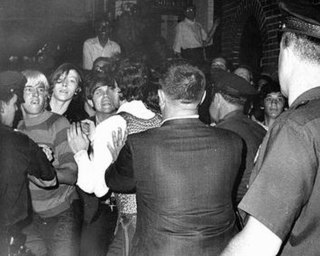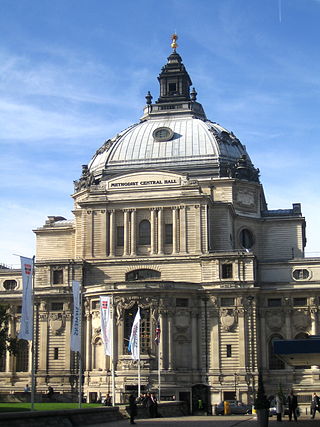
The Stonewall riots, also known as the Stonewall uprising, Stonewall rebellion, or simply Stonewall, were a series of protests by members of the gay community in response to a police raid that began in the early morning hours of June 28, 1969, at the Stonewall Inn in the Greenwich Village neighborhood of Lower Manhattan in New York City. Patrons of the Stonewall, other Village lesbian and gay bars, and neighborhood street people fought back when the police became violent. The riots are widely considered the watershed event that transformed the gay liberation movement and the twentieth-century fight for LGBT rights in the United States.

Queer is an umbrella term for people who are not heterosexual or are not cisgender. Originally meaning 'strange' or 'peculiar', queer came to be used pejoratively against those with same-sex desires or relationships in the late 19th century. Beginning in the late 1980s, queer activists, such as the members of Queer Nation, began to reclaim the word as a deliberately provocative and politically radical alternative to the more assimilationist branches of the LGBT community.

Sexuality and gender identity-based cultures are subcultures and communities composed of people who have shared experiences, backgrounds, or interests due to common sexual or gender identities. Among the first to argue that members of sexual minorities can also constitute cultural minorities were Adolf Brand, Magnus Hirschfeld, and Leontine Sagan in Germany. These pioneers were later followed by the Mattachine Society and the Daughters of Bilitis in the United States.
Sissy, also sissy baby, sissy boy, sissy man, sissy pants, etc., is a pejorative term for a boy or man who does not demonstrate masculine traits, and shows possible signs of fragility. Generally, sissy implies a lack of courage, strength, athleticism, coordination, testosterone, male libido, and stoicism. A man might also be considered a sissy for being interested in typically feminine hobbies or employment, displaying effeminate behavior, being unathletic or being homosexual.

In gay culture, a bear is a larger and often hairier man who projects an image of rugged masculinity.

Leather subculture denotes practices and styles of dress organized around sexual activities that involve leather garments, such as leather jackets, vests, boots, chaps, harnesses, or other items. Wearing leather garments is one way that participants in this culture self-consciously distinguish themselves from mainstream sexual cultures. Many participants associate leather culture with BDSM practices and its many subcultures. For some, black leather clothing is an erotic fashion that expresses heightened masculinity or the appropriation of sexual power; love of motorcycles, motorcycle clubs and independence; and/or engagement in sexual kink or leather fetishism.

Butch and femme are masculine (butch) or feminine (femme) identities in the lesbian subculture which have associated traits, behaviors, styles, self-perception, and so on. This concept has been called a "way to organize sexual relationships and gender and sexual identity". Butch–femme culture is not the sole form of a lesbian dyadic system, as there are many women in butch–butch and femme–femme relationships.

Sylvester James Jr., known mononymously as Sylvester, was an American singer-songwriter. Primarily active in the genres of disco, rhythm and blues, and soul, he was known for his flamboyant and androgynous appearance, falsetto singing voice, and hit disco singles in the late 1970s and 1980s.

Touko Valio Laaksonen, known by the pseudonym Tom of Finland, was a Finnish artist who made stylized highly masculinized homoerotic art, and influenced late 20th-century gay culture. He has been called the "most influential creator of gay pornographic images" by cultural historian Joseph W. Slade. Over the course of four decades, he produced some 3,500 illustrations, mostly featuring men with exaggerated primary and secondary sex traits, wearing tight or partially removed clothing.
Effeminacy is the embodiment of feminine traits in boys or men, particularly those considered untypical of men or masculinity. These traits include roles, stereotypes, behaviors, and appearances that are socially associated with women and girls. Throughout history, men considered effeminate have faced prejudice and discrimination. Gay men are often stereotyped as being effeminate, and vice versa. However, femininity, masculinity, and other forms of gender expression are independent of sexual orientation.

LGBT stereotypes are stereotypes about lesbian, gay, bisexual and transgender (LGBT) people are based on their sexual orientations, gender identities, or gender expressions. Stereotypical perceptions may be acquired through interactions with parents, teachers, peers and mass media, or, more generally, through a lack of firsthand familiarity, resulting in an increased reliance on generalizations.
Swish is a US English slang term for effeminate behavior and interests (camp), emphasized and sanctioned in gay male communities prior to the Stonewall riots. This behaviour is also described as being nelly in British English, and both terms are often considered to be derogatory.

Clothing fetishism or garment fetishism is a sexual fetish that revolves around a fixation upon a particular article or type of clothing, a particular fashion or uniform, or a person dressed in such a style.
In gay slang, queen is a term used to refer to a flamboyant or effeminate gay man. The term can either be pejorative or celebrated as a type of self-identification.
Metrosexual is a term describing a man in an urban, post-industrial, capitalist culture who is especially meticulous and scrupulous about his personal style, grooming and appearance. It is often used to refer to heterosexual men who are perceived to be feminine rather than masculine and having traits typical of effeminate men. Nevertheless, the term does not assert whether a metrosexual is heterosexual, gay or a bisexual man, and the gender or sexual orientation of a metrosexual is generally ambiguous and differs in every man. Some academics consider metrosexuals to be exhibiting narcissistic tendencies.

On 9 September 1971 the UK Gay Liberation Front (GLF) undertook an action to disrupt the launch of the Church-based morality campaign Nationwide Festival of Light at the Methodist Central Hall, Westminster. A number of well-known British figures were involved in the disrupted rally, and the action involved the use of "radical drag" drawing on the Stonewall riots and subsequent GLF actions in the US. Peter Tatchell, gay human rights campaigner, was involved in the action which was one of a series which influenced the development of gay activism in the UK, received media attention at the time, and is still discussed by some of those involved.

The lesbian, gay, bisexual and transgender (LGBT) community in San Francisco is one of the largest and most prominent LGBT communities in the United States, and is one of the most important in the history of American LGBT rights and activism alongside New York City. The city itself has been described as "the original 'gay-friendly city'". LGBT culture is also active within companies that are based in Silicon Valley, which is located within the southern San Francisco Bay Area.

The Castro District, commonly referred to as the Castro, is a neighborhood in Eureka Valley in San Francisco. The Castro was one of the first gay neighborhoods in the United States. Having transformed from a working-class neighborhood through the 1960s and 1970s, the Castro remains one of the most prominent symbols of lesbian, gay, bisexual, and transgender (LGBT) activism and events in the world.
Gender roles in non-heterosexual communities are a topic of much debate; some people believe traditional, heterosexual gender roles are often erroneously enforced on non-heterosexual relationships by means of heteronormative culture and attitudes towards these non-conformative relationships.

Femboy ( ), also spelled femboi, is a slang term for a male or non-binary individual who expresses themselves with traditionally feminine behaviours. As an internet aesthetic, this may be through the use of jewellery, wearing feminine clothing and makeup, or expressing feminine behavioural qualities. Femboy can be used as both a sexual and non-sexual term; it does not denote a specific sexual orientation or gender role, but instead marks a form of gender variance.












